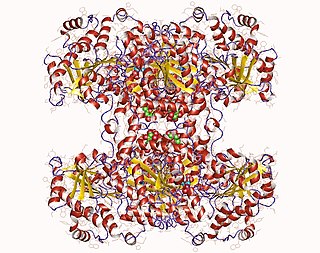
Glycogen phosphorylase is one of the phosphorylase enzymes. Glycogen phosphorylase catalyzes the rate-limiting step in glycogenolysis in animals by releasing glucose-1-phosphate from the terminal alpha-1,4-glycosidic bond. Glycogen phosphorylase is also studied as a model protein regulated by both reversible phosphorylation and allosteric effects.

Glycogen synthase is a key enzyme in glycogenesis, the conversion of glucose into glycogen. It is a glycosyltransferase that catalyses the reaction of UDP-glucose and n to yield UDP and n+1.
Starch phosphorylase is a form of phosphorylase similar to glycogen phosphorylase, except that it acts upon starch instead of glycogen.

Myophosphorylase or glycogen phosphorylase, muscle associated (PYGM) is the muscle isoform of the enzyme glycogen phosphorylase and is encoded by the PYGM gene. This enzyme helps break down glycogen into glucose-1-phosphate, so it can be used within the muscle cell. Mutations in this gene are associated with McArdle disease, a glycogen storage disease of muscle.

Sucrose phosphorylase is an important enzyme in the metabolism of sucrose and regulation of other metabolic intermediates. Sucrose phosphorylase is in the class of hexosyltransferases. More specifically it has been placed in the retaining glycoside hydrolases family although it catalyzes a transglycosidation rather than hydrolysis. Sucrose phosphorylase catalyzes the conversion of sucrose to D-fructose and α-D-glucose-1-phosphate. It has been shown in multiple experiments that the enzyme catalyzes this conversion by a double displacement mechanism.
In enzymology, a 1,3-beta-D-glucan phosphorylase is an enzyme that catalyzes the chemical reaction
In enzymology, a 1,3-beta-oligoglucan phosphorylase is an enzyme that catalyzes the chemical reaction
In enzymology, an alpha,alpha-trehalose phosphorylase is an enzyme that catalyzes the chemical reaction
In enzymology, an alpha,alpha-trehalose phosphorylase (configuration-retaining) is an enzyme that catalyzes the chemical reaction
In enzymology, a cellodextrin phosphorylase is an enzyme that catalyzes the chemical reaction
In enzymology, a glucosylglycerol-phosphate synthase is an enzyme that catalyzes the chemical reaction
In enzymology, a laminaribiose phosphorylase is an enzyme that catalyzes the chemical reaction

In enzymology, a maltose phosphorylase is an enzyme that catalyzes the chemical reaction
In enzymology, a trehalose 6-phosphate phosphorylase is an enzyme that catalyzes the chemical reaction
Beta-D-galactosyl-(1->4)-L-rhamnose phosphorylase is an enzyme with systematic name beta-D-galactosyl-(1->4)-L-rhamnose:phosphate 1-alpha-D-galactosyltransferase. This enzyme catalyses the following chemical reaction
Nigerose phosphorylase is an enzyme with systematic name 3-O-alpha-D-glucopyranosyl-D-glucopyranose:phosphate beta-D-glucosyltransferase. This enzyme catalyses the following chemical reaction
4-O-beta-D-mannosyl-D-glucose phosphorylase is an enzyme with systematic name 4-O-beta-D-mannopyranosyl-D-glucopyranose:phosphate alpha-D-mannosyltransferase. This enzyme catalyses the following chemical reaction
3-O-alpha-D-glucosyl-L-rhamnose phosphorylase is an enzyme with systematic name 3-O-alpha-D-glucopyranosyl-L-rhamnopyranose:phosphate beta-D-glucosyltransferase. This enzyme catalyses the following chemical reaction
(1→4)-α-D-Glucan 1-α-D-glucosylmutase is an enzyme with systematic name (1->4)-alpha-D-glucan 1-alpha-D-glucosylmutase. This enzyme catalyses the following chemical reaction
Maltodextrin phosphorylase is a phosphorylase enzyme, more specifically one type of glycosyltransferase. Maltodextrin phosphorylase plays a critical role in maltodextrin metabolism in E. coli. This bacterial enzyme, often referred to as MalP, catalyzes the phosphorolysis of an α-1,4-glycosidic bond in maltodextrins, removing the non-reducing glucosyl residues of linear oligosaccharides as glucose-1-phosphate (Glc1P). Phosphorylases are well-regarded for their allosteric effects on metabolism, however MalP exhibits no allosteric properties. It has a higher affinity for linear oligosaccharides than the related glycogen phosphorylase.





